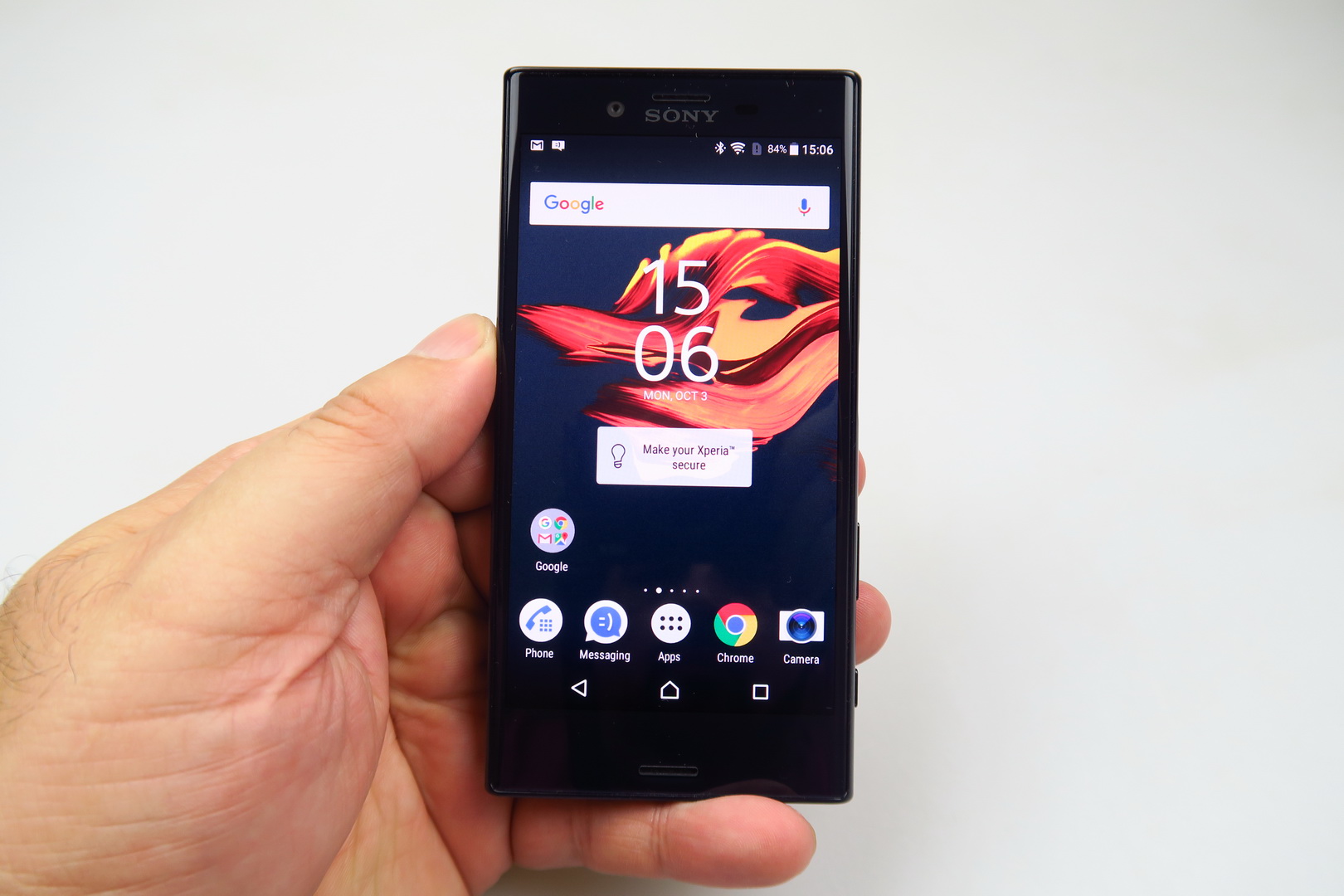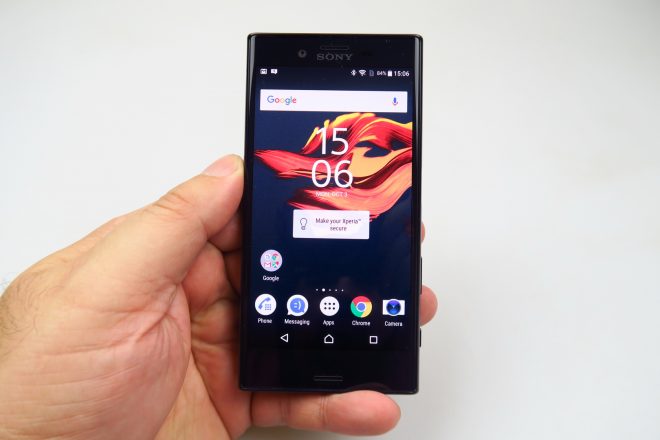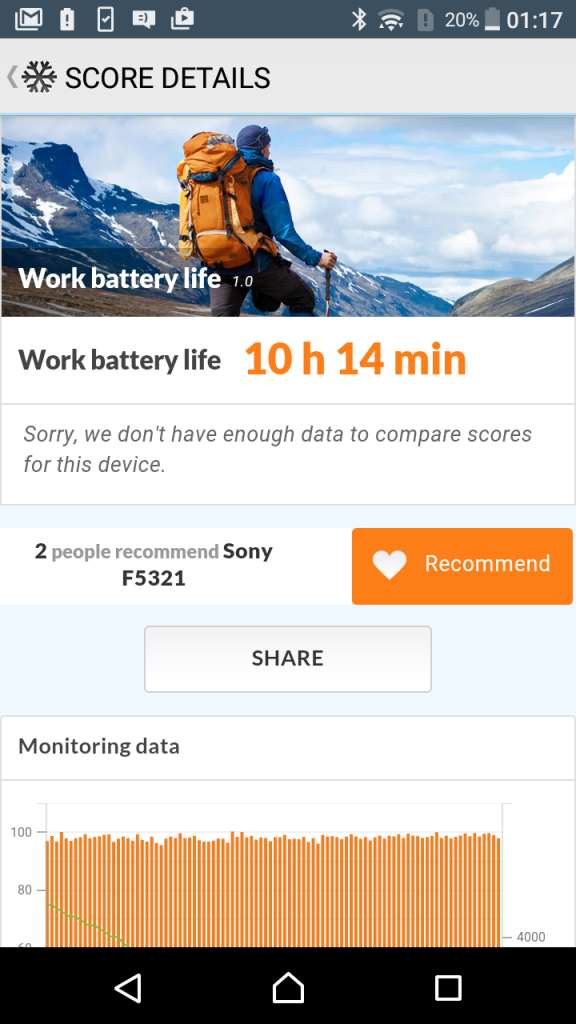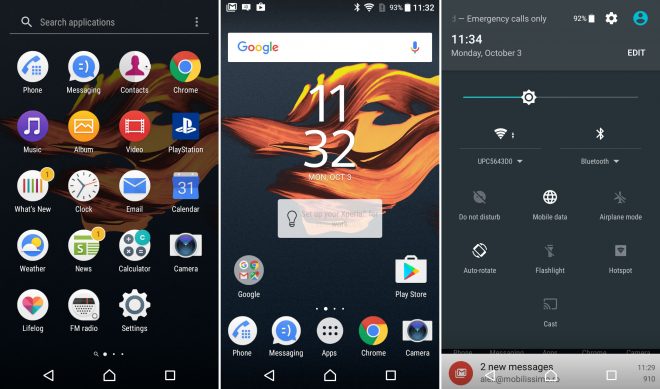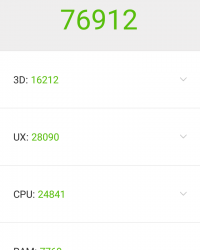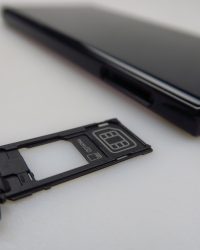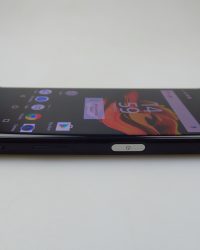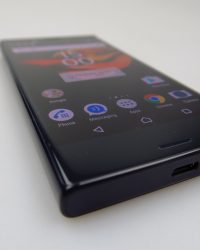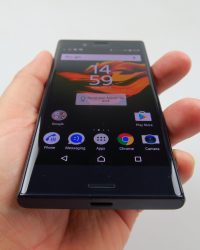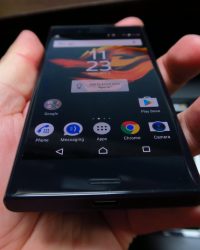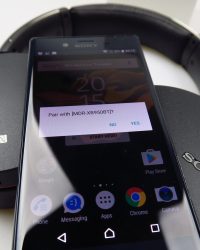It’s hard to name niches nowadays. There’s battery phones, there’s phablets, phablets as big as tablets, upper midrange models and… “small phones”. Apple wouldn’t be caught dead with its 4.7 inchers bearing that name, but Sony wouldn’t mind that tagline for the Xperia Compact series. The Sony Xperia X Compact is an important part of that range and it gets reviewed below. The device is priced at around $440.
Considered the smaller version of the Xperia X, this model was unveiled at IFA 2016 and it’s positioned as an iPhone SE rival. Sony has an unique approach as usual with its compact phones and this 4.6 incher is quite the cameraphone. Available in blue, black or white, the device somehow ditches the waterproofing and offers a thick device, with a small brick aspect.
It sits well in the user’s hand and it’s not slippery. It’s a fingerprint magnet, both at the front and black and it measures 9.5 mm in thickness, while weighing 135 grams. As a comparison the Xperia Z3 Compact weighs 129 grams and measures 8.6 mm in thickness. The X Compact is also beefier than the 8.9 mm Xperia Z5 Compact, but it’s also 3 grams lighter.
It’s a pretty thick handset for 2016 and provides comfy one hand usage. The Power button has good feedback, but the volume and camera buttons aren’t the comfiest in the world, or the best placed on the lower side of the phone. Made of shiny plastic, this model feels like it’s well built, but it also feels a bit like a toy. It fits any pocket and the back scratches quite easily.
It’s not premium or waterproof, which is a letdown, but at least it’s pretty comfy. Sony Xperia X Compact has a 4.6 inch screen, with a 720p resolution and an IPS LCD panel. There’s the usual X Reality and Triluminous tech, plus Gorilla Glass protection and Dynamic. Contrast. The video player preinstalled on the device has a TV Guide included, top picks shown, popular stuff, things that are on air and a Movies and Sports section. Audio Settings for the video playback include the usual DSEE, Clear Audio+ and Sound Effects.
There are also subtitle settings and display settings, which we’ll address later. The actual viewing experience was bright, crisp, offered wide view angles, but it was also oversaturated. Contrast is rather OK and the black isn’t deep. Pixels are of the RGB Stripes variety and the luxmeter showed a value of 533 LUX, which is great. It’s superior to the Nexus 6P, HTC 10 and Huawei P9, but scores below the iPhone 6 and Xperia XZ.
I promised you settings and here they are: Adaptive Brightness, Smart Backlight Control, Image Enhance (Off, X Reality, Super Vivid), White Balance, Font Size and Glove Mode. It’s a solid screen and the oversaturation bit can be removed once you activate the X Reality mode. Now off to the CPU department, where we find the Qualcomm Snapdragon 650 chipset, a hexa core 64 bit affair, with Adreno 510 GPU and 3 GB of RAM to accompany it.
There’s 32 GB of storage, a microSD card slot and the device doesn’t suffer from lag and it brings a fluid UI. However, some of the apps start up slow, for some reason. Games, such as Riptide GP Renegade run just fine, looking fine and suffering no hitch. Benchmarks such as Quadrant gave us excellent results, so we surpassed the LeEco Le Max 2 and HTC one M9 for example, while in AnTuTu 6 we went past Microsoft Lumia 950 XL and LG V10.
3DMark Ice Storm Unlimited places the phone above the Galaxy S5 and below the Lenovo Vibe X3, while in GeekBench 3 we beat the ASUS ZenFone 3 in the single core test. The temperature reaches 40.6 degrees after playing the game Riptide, which is a bit high, but not exaggerated, plus 33.1 degrees Celsius after running GFXBench.
On the battery front we’re treated to a 2700 mAh unit, with Adaptive Charging and the same capacity as the Xperia Z5 Compact. Our HD video playback test revealed a time of 11 hours and 22 minutes, which is great and certainly worth the device’s thickness. It surpassed the Galaxy S6 Edge Plus and Lenovo Vibe X3, but scored below the iPhone 6 by 8 minutes. In PCMark we registered a HUGE 10 hours and 14 minutes, placing this phone on the seventh spot all time, from all the phones we’ve tested.
We surpassed the Galaxy S7 Edge and Huawei Mate 8, as well as the Samsung Galaxy A5 (2016), but scored below the Xiaomi Redmi Note 3 Pro and Ulefone Power. Charging requires 2 hours and 28 minutes, a pretty good duration in my book. This charging time is superior to the one of the HTC One M8 and iPhone 7, but inferior to the iPhone SE.
Settings include Battery Optimization, Stamina Mode (background data moderated, GPS, Image Enhance removed and more), plus Ultra Stamina Mode (WiFi, mobile off, only basic apps kept). There’s also Battery Care that limits charging to less stressful values during the night time. It’s possibly the best small phone battery I’ve ever seen. On the audio front, the Sony Xperia X Compact has stereo speakers upfront, its player has FLAC support and there’s also stereo recording and digital noise cancelling.
The Music app integrates Spotify and it has a pretty nice UI. Options include DSEE HX, which upgrades compressed music to Hi Res audio, Clear Audio+, Sound Effects (EQ with genres and 5 channels to tweak, plus Clear Bass). Then we’ve got headphone surround (studio, club or hall), S Force Surround, Dynamic Normalizer and microphone sensitivity.
The listening experience brought us a loud and clear sound, solid bass, nice voice and some distortion when listening to rock. The back vibrates pretty badly and the decibelmeter test we did got us to 81.7 dBA, at the front and 79.2 dBA at the back. The muffling is not that bad in real life, I have to say. These values surpassed the ones of the Huawei Honor 5X and Xiaomi Mi 5, but are inferior to the ones of the iPhone SE and Xperia Z5.
Headphones that we connected to the device (none bundled, we used EarPods), weren’t very loud, but the experience was crisp. We also have FM radio and the acoustics are quite solid, but the volume could be higher. Now it’s time to address the camera, since we kept calling this phone a cameraphone. There’s a 23 megapixel back camera here, which should be the same as the one from the Xperia XZ.
It’s got triple image sensing, predictive hybrid AF and a 1/2.3 inch Exmor R sensor, plus a 24 mm wide angle Sony G Lens. There’s 5X clear image zoom, Bionz processing and Steadyshot 5 axis stabilization. Of course, we also have laser focus and a RGBC-IR sensor, plus LED flash. Upfront there’s a 5 megapixel shooter, 25 mm wide angle lens and a 1/5 inch Exmor R sensor.
The camera app starts up fast and the cam offers mid level autofocus, OK touch focus and fluid zoom up to 8X. The camera UI is the same one from the Xperia XZ and picture taking is a bit on the slow side. The main modes are Superior Auto, which also has options for color and brightness, as well as resolution (23 MP in 4:3 or 20 MP in 16:9 for example).
There’s also object tracking and then we move on to the Manual Mode, that lets you tweak, scene, white balance, focus, exposure, shutter, HDR, ISO and metering. Videos are shot in Full HD at 30 or 60 FPS and there’s no 4K here. We also have Camera apps, that include panorama, augmented reality and a few more. The gallery of shots taken with this phone was done on a sunny day of October and we caught some crisp and good looking shots, with realistic colors and a pretty OK HDR.
The water of the lake we photographed had great texture and we could zoom into the landscapes all we liked, without losing too many details. Closeups are rather solid and the selfies are also excellent, with one of the best skin textures I’ve ever seen. There’s no blur in the main camera shots and everything is well calibrated.
I like the exposure here, the white balance and focus, plus the focus play with that metal acorn. The Panorama was rather small, at 4912 x 1080 pixels and we also caught some perfect leaves in the process. The dynamic range of pictures was great and I feel that these shots surpass the quality of the ZenFone 3 pictures and most Huawei models.
Shots taken in the shade are very crisp and well light and I’ve been generally very happy with the result of the shots taken with this camera. The iPhone 7 pics seem washed out compared to the ones of the Xperia X Compact. It’s certainly the best sub 5 inch phone of 2016, in the camera area. Low light shots had big halos, but OK clarity and we also liked the texture of monuments we saw.
There’s some blur in the pics with yellow street lighting, but somehow when the lights are blue and you’re using the phone during a concert, everything gets clearer. We liked the exposure, white balance and focus, but also had some blue hue around the edges, much like the Xperia XZ. The flash was excellent, as shown by that hydrant shot, both bright and without compromising the quality of the pic.
Overall, I’d place this low light capture below the OnePlus 3, iPhone 7 and above the Xperia Z5. Video capture is shot in MP4 format, at 30 FPS and 17 Mbps. Stabilization is excellent, the one triggered via Steadyshot Intelligent Mode, of course. There’s no strange motion or image jerk here, but we did have some problems with the wind and microphone.
We also found that focus loss happened every once in a while. The 60 FPS video was a bit burnt, but very clear and had a solid mic recording. Zooming into the ducks in the park resulted in detail loss and in general we felt that the clarity was OK and we had a great tree texture. Choosing Steadyshot Standard stabilization results in a shakier image, keep that in mind.
I was totally underwhelmed by the hue of green here and the colors in general, not too well calibrated, sadly. Everything is OK in the end, but it’s not flagship level, video-wise. Stabilization may be top notch, but colors are a big problem, one that the Xiaomi Mi 5 also has, for example. Somehow, this cam is also about 10% below the one of the Xperia XZ, although on paper they’re the same.
Low light filming brings the yellow hue problems into our attention and also some poor zoom. The microphone was able to handle a concert like a champ, clarity was OK and we also had some nice colors during the event. Object tracking was solid, but once you move into areas lit by yellow street lights, you’ll surely be bummed out by the quality of the image.
It’s a mixed behaviour of the cam, with excellent day time shots, mixed night time ones and also mixed videos, but with great stabilization. Now that the camera is done and dusted, let’s see how the device behaves when it comes to web browsing. We rely on Chrome here, that works fast and also has solid benchmark results. The virtual keyboard on this small phone is Swiftkey, with well spaced buttons and swiping between letters.
Connectivity brings up an interesting aspect: even though the SIM card slot has a lid, it doesn’t require a metal key to open it, but rather just prying it out with a fingernail, which is easily done. The phone is a single SIM affair, with a nano SIM card slot and support for LTE Category 6. There’s GPS and Glonass here, Miracast too, plus DLNA, NFC and Bluetooth 4.2.
WiFi a/b/g/n/ac and USB Type C are included among the connectivity options and moving on to calls, we got smart call handling here, loud and clear calls, plus pretty good signal. The microphone was solid and we’re actually dealing with two noise cancelling mics. We also did a SpeedTest, with excellent results, including 269 Mbps in download speed on WiFi and 25 Mbps in upload. 4G brought a 45 Mbps download speed and 45 Mpbs upload, being a bit of a letdown, compared to the excellent WiFi.
Xperia X Compact runs Android 6.0.1 Marshmallow, with the typical Xperia UI on top, which means it’s a flat and colorful experience, filled with side menus. It’s the same experience as on the Xperia XZ by the way. Multitasking is done via a carousel and the leftmost homescreen is dedicated to Google Now. Swiping down on homescreens triggers a search, while keeping a homescreen pressed offers up widgets, many of them non stock and pretty complex looking.
Then there are the themes and wallpapers, plus settings for icon size, icon packs and transitions. Swiping down from the top part of the screen shows notifications and Quick Settings. Moving to the actual Settings, that’s where we find the fingerprint scanner options, and this sensor is integrated within the Power button on the right of the device.
It involves a 20 step setup process, it’s fast and accurate and other than that I was surprised to see where were no special gestures or options here in the Settings. The preinstalled apps list includes 47 names, which is pretty much bloatware, if you ask me. The list includes Amazon, AVG, Lifelog, Movie Creator, News, PS4 Remote Play, Spotify and What’s New, so quite a few preinstalled apps and many non removable ones.
I guess it’s now time for the verdict! So, let’s start with the Pros and Cons.
These are the Pros:
- good video stabilization
- fits any pocket
- bright screen
- good performance
- solid battery
- stereo audio
- good pictures
- solid details in pictures
- nice selfies
- good concert video capture
- powerful microphones
- fast WiFi
And the Cons:
- quite a few preinstalled apps
- easily scratched case
- fingerprint magnet front/back
- oversaturated screen
- could be louder
- blue huge in night pics
- volume button not comfy
- not waterproof
As a conclusion, this is one of the best sub 5 inch phones on the market and certainly the best small screen cameraphone out there. It’s comfy, has an excellent battery, it can “tape” concerts in excellent fashion and performance is not shabby at all. I’d see it as a journalist’s phone, also a blogger’s and videoblogger’s, perhaps one for nature enthusiasts.
It’s got a good performance, it’ll receive Nougat fast and is nice for enjoying media on the go, via its speakers and bright screen. Possibly the best Xperia Compact so far, minus lack of wateproofing and beefed up design. You can get the device here.

